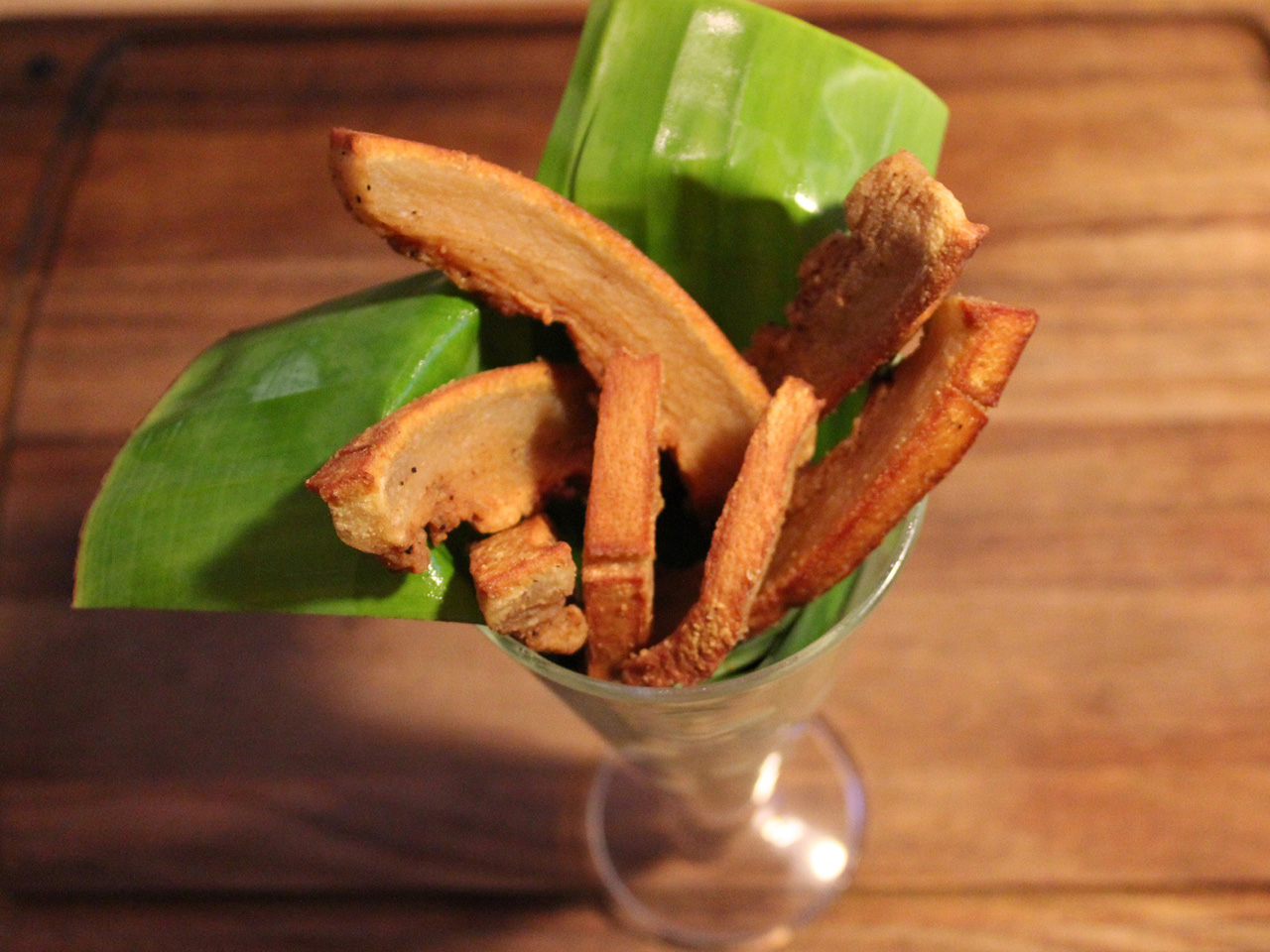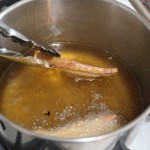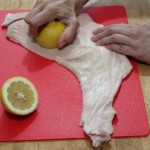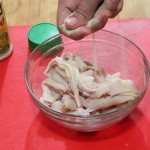In Puerto Rico we have a town nicknamed Pork Rind City and lechoneras that line a whole highway. Pork crackling is our drug. In any given plaza you will find cart after cart overflowing with chicharron. So many that it’s hard to imagine any pigs on the island have their skin intact.
My mother loves crackling so much that Thanksgiving 1985 was almost ruined when one of my aunts nabbed the coveted piece of crunchy skin on the pernil before it had been served. When my mother made the discovery (as she went to sneak a piece for herself) she spit out “How could you!” in a tone of disgust usually reserved for dog kickers. All hell broke loose in our tiny 10 by 5 open kitchen with the insults snowballing between sisters. When my mom called my aunt a pendeja the men took their conversation to the back yard and I sat on our new floral print couch mesmerized waiting for someone to throw a punch.
The punches never came, the insults died down. Several cigarettes were lit and glasses of Reunite were refilled. The music was turned up. The sisters glowered at each other as grace was quickly said, the pernil pale where it’s crispy caramelized skin had once been.
I understand now my mother’s deep sense of loss. There is nothing like the succulent promise of chicharron. The time spent scoring the skin on the pork shoulder. The care taken when rubbing it down with garlic and oregano, salt and pepper making sure to tuck the spices into every nook. The patience it takes to let the meat marinate over night before getting up early the next morning and cooking it low and slow so the layer of fat under the epidermis melts at a snail’s pace and then bursts out, basting the skin over and over again. Checking in on your treasure every hour on the hour, imagining the mouth-watering glee as your fingers finally wrap around a piece of that heavenly crust. The thunderous crunch of it. The way it sticks to your teeth. The perfect marriage of salt and pork fat on your lips.
To have that all taken away by the greedy hands of someone who shares your blood. I would have called her a pendeja too.
I am not my mother. I will not labor a whole day to get my hands on chicharron. This is my recipe for what I call “cheater’s” pork crackling that is ready in twenty minutes. It’s not traditional. It’s heresy. And I’m ok with that. You will be too. TRUST.
This chicharron will not have the light bubbled airy skin of the classic recipe. It will not have most of the fat rendered out. The rind will be salty and crispy, like a potato chip. The hot fat will have an initial crunch and then a glorious gelatinous mouth feel that makes you groan and then promise yourself a work out later. These pork cracklings are incredible dipped in pico de gallo or with a simple squeeze of lemon or a dash of vinegar. You can also dice the strips for a sort of crouton that pairs wonderfully with chicken and salad greens or as a topping for habichuelas. I’ve never had any left over, but if you do you can store them in an airtight container lined with paper towels.
This preparation is dedicated to my mother, who at 60 will still destroy you if you eat all the chicharron. My soundtrack is Caballo Viejo by Roberto Torres.
Tools
- Heavy bottomed sauce pan
- Tongs
- Thermometer
Ingredients
- Slab of pork skin
- Half a lemon
- Adobo Goya to taste
- Corn oil for frying
Directions
- Rub the pork skin down with a lemon half, then pat dry with paper towels.
- Slice the pork skin in 1/2 thick strips, and then salt generously with Adobo Goya. Lay the strips flat on paper towels for fifteen minutes.
- Fill a heavy bottomed sauce pan halfway with corn oil and using a medium low heat bring it to 350 degrees. For a more complex flavor you can substitute pork lard for the corn oil.
- Shake off any excess Adobo from the pork skin and dry again with paper towels.
- When the oil has come to temperature turn up the heat a little and carefully place four or five of the strips in the pan, always away from you.
- Let the skins crisp up to a golden brown (about 5 minutes) and then remove from the pan using tongs, resting them on a plate lined with paper towels.
- Repeat. The first batch of crackling will be gone in minutes.
Gallery
- Cook the chicharron until some of the fat has rendered and the skin is golden brown.
- I sliced this slab of skin off a shoulder roast I bought at one of my favorite Mexican markets. You can also buy it at most butcher shops.
- After cutting the skin into ribbons generously salt it with adobo.






Hey MC! Long time…hope all is well. Looks as much from all the times I’ve seen you online out on tv. Life is sure a while lot different sine you and I jumped out of a perfectly good plane.
My question for you is this. Traditionally, it is my understanding that you have to use a suckling pig for chicharrones. Does this recipe require the skin from a suckling pig? Can you get a good chicjarrin from an adult pig? (My in laws raise pigs). Did you get the skin from the grocery store, butcher?
Anyway I look forward to trying this recipe. My heart and arteries dont, but you only live once.
Take care!
Rob
PAFUNDI!!! How are you?!?! OMG we had some good times, though skydiving was def a highlight!! You’re the best mister! I love that you know pig farmers. Suckling anything will always be better but you can make chicharron from any pig skin. I went to a Mexican market and got pork shoulder with the skin on. I removed the skin from the shoulder, leaving a thin layer of fat and gave it a good scrubbing with lemon. Mine is not airy and super hard crunchy like traditional chicharron. It;s crunchy mind you, you just won’t have to worry about knocking out a tooth. Thank you so much for reading my blog! It’s so great to hear from you!
Although I am allergic to pork, yes probably the only Puerto Rican I know with that allergy. I can appreciate the love people have for chicharon or chicharon de pollo which I love. I absolutely love the stories you give about recipe and how it pertains to Puerto Rican culture and your life. It really takes me back to my parents home and growing up Puerto Rican. I also absolutely love that you add a “soundtrack” to each one.
Keep them coming cause I will keep reading them.
Thank You for what you do.
Thank you so much Monty! You made my day!
My wife and I drive 4 hours round trip, twice a month to buy pork belly. Lechon kawali lechon liempo and chicharron are all on the menu weekly in our home. She is from the Philippines, so I try to give her a taste of home,. We are going this weekend since our freezer is empty. I will try your recipe and see how it compares. In my book, no such thing as a bad pork recipe. Just good, great and better.
Wow! Mad respect. Lechon kawali is one of my favorite things as well. These are like little chicharron shoestring fries. I hope you and your wife love it! Send me pics!
Llego tarde a la fiesta como siempre.
Chicharrón is also HUGE in Colombia (where I’m from), and I learned how to make it without oil, but reading your experiences and love of it makes me happy. I can’t eat it anymore (my gallbladder quit!), but I like reading recipes with it.
From a new reader in Sudamérica.
Gracias por la visita Andrea!